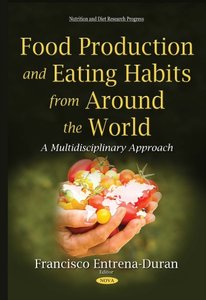Food Production and Eating Habits from Around the World: A Multidisciplinary Approach by Francisco Entrena-duran
English | 2015 | ISBN: 1634824962, 1634825403 | 316 pages | PDF | 3,3 MB
English | 2015 | ISBN: 1634824962, 1634825403 | 316 pages | PDF | 3,3 MB
This book brings together a selection of studies written by specialists from universities and/or research institutions from every continent. The processes of change in systems of production, commercialization, and consumption of food, as well as the problems and nutritional habits analyzed here, develop within the framework of the technological and socio-productive transformations experienced in many parts of the world as a consequence of the transition from traditional rural societies to the predominantly urban and industrial societies of our time. Many of these societies are affected by the fluctuations, questions, or socioeconomic uncertainties caused principally by what is named globalization.
The authors involved in this volume are from a variety of backgrounds and their theoretical-analytical focuses regarding eating habits are quite diverse. However, independent of their different perspectives and scientific disciplines (Anthropology, Communication, Economy, Marketing, Medicine, Nursing, Psychology and Sociology), all of these authors are united in their concerns regarding similar food processes and problems, such as the industrialization of food production, junk food, fast food, eating disorders, overeating, obesity, the impacts of ideal body images on eating behaviors, lifestyles and feeding, anorexia, bulimia, organic foods, healthy foods, functional foods, and so on. Moreover, in a time shaped by a worldwide standardization of eating habits, the search for identity, specificity, or distinction through the acquisition and consumption of foods is commonplace in many chapters of the book. Likewise, these chapters show a generalized interest on the negative effects of the advertising and communications media that often drive patterns of food consumption and provoke desires for ideals of beauty and body forms prejudicial to health.
As the editor states in the preface, all this occurs in an ever more modernized and globalized world in which artificial procedures of the production of industrial foods that are quite opaque to the general public become increasingly widespread. In such a world, while people's concerns over the healthiness of foods increase, we are witnessing a non-stop expansion of markets for organic food, as well as the repeated manipulation of growing consumers' preferences for certain foodstuffs that they believe are healthy or have specific natural qualities. This manipulation frequently takes place through a variety of advertisements that announce a series of industrial foods as supposedly possessing these qualities. Obviously, a priority objective of these and other advertising strategies is to increase sales in the agro-alimentary sector in a context of obvious overproduction and oversupply, which in turn is translated into the stimulation of food consumption. This would help explain such developments in the current consumer society, which is explored in further detail in many chapters of this book.
My nickname - interes



